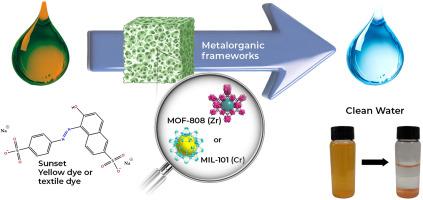Metal–organic frameworks for high-performance removal of sunset yellow dye: Combined Box-Behnken design and theoretical insights into adsorption
IF 4.7
3区 材料科学
Q1 CHEMISTRY, APPLIED
引用次数: 0
Abstract
The development of efficient and reusable adsorbents for dye removal from wastewater is crucial for sustainable environmental management. In this study, two highly porous and chemically stable metal–organic frameworks, MOF-808(Zr) and MIL-101(Cr), were investigated for the adsorption of the anionic dye Sunset Yellow (SY) from aqueous media. PXRD confirmed the successful synthesis and stability of both MOFs, even after adsorption. Their large surface areas, 756.62 m2 g−1 for MOF-808(Zr) and 1858.04 m2 g−1 for MIL-101(Cr), contributed directly to the high adsorption capacities observed. Zeta potential measurements revealed a strong pH-dependence of surface charge and adsorption efficiency. Process optimization using a Box–Behnken design led to SY removal rates above 99 %. Kinetic data followed a pseudo-second-order model, indicating chemisorption as the dominant mechanism. X-ray photoelectron spectroscopy (XPS) provided further insights, showing π–π interactions between SY and aromatic linkers in MOF-808, while in MIL-101 the data suggested delocalization, polarization, or charge transfer. FTIR spectra before and after adsorption corroborated these interactions. Density functional theory (DFT) calculations supported the experimental findings, highlighting the strong affinity of SY molecules for the framework nodes and linkers. UV–vis diffuse reflectance analysis offered complementary information on the electronic environment during adsorption. Importantly, MIL-101(Cr) maintained high efficiency over four cycles, and ICP-OES confirmed negligible metal leaching, underscoring the material's robustness. Both MOFs also performed efficiently in real textile wastewater, demonstrating their potential as sustainable adsorbents for environmental remediation.

金属有机框架的高性能去除日落黄染料:结合盒- behnken设计和吸附理论见解
开发高效和可重复使用的吸附剂来去除废水中的染料对于可持续的环境管理至关重要。研究了MOF-808(Zr)和MIL-101(Cr)这两种具有高孔隙度和化学稳定性的金属有机骨架对阴离子染料日落黄(SY)的吸附性能。PXRD证实了这两种mof的成功合成和稳定性,即使在吸附后也是如此。MOF-808(Zr)的表面积为756.62 m2 g−1,MIL-101(Cr)的表面积为1858.04 m2 g−1,这直接导致了MOF-808(Zr)的高吸附能力。Zeta电位测量表明,表面电荷和吸附效率对ph有很强的依赖性。使用Box-Behnken设计的工艺优化使SY去除率达到99%以上。动力学数据遵循伪二阶模型,表明化学吸附是主要机理。x射线光电子能谱(XPS)提供了进一步的见解,在MOF-808中显示了SY和芳香连接物之间的π -π相互作用,而在MIL-101中,数据表明了离域,极化或电荷转移。吸附前后的FTIR光谱证实了这些相互作用。密度泛函理论(DFT)计算支持实验结果,突出了SY分子对框架节点和连接体的强亲和力。紫外-可见漫反射分析提供了吸附过程中电子环境的补充信息。重要的是,MIL-101(Cr)在四个循环中保持了高效率,ICP-OES证实金属浸出可以忽略不计,强调了材料的稳健性。这两种MOFs在实际纺织废水中也表现有效,显示了它们作为环境修复的可持续吸附剂的潜力。
本文章由计算机程序翻译,如有差异,请以英文原文为准。
求助全文
约1分钟内获得全文
求助全文
来源期刊

Microporous and Mesoporous Materials
化学-材料科学:综合
CiteScore
10.70
自引率
5.80%
发文量
649
审稿时长
26 days
期刊介绍:
Microporous and Mesoporous Materials covers novel and significant aspects of porous solids classified as either microporous (pore size up to 2 nm) or mesoporous (pore size 2 to 50 nm). The porosity should have a specific impact on the material properties or application. Typical examples are zeolites and zeolite-like materials, pillared materials, clathrasils and clathrates, carbon molecular sieves, ordered mesoporous materials, organic/inorganic porous hybrid materials, or porous metal oxides. Both natural and synthetic porous materials are within the scope of the journal.
Topics which are particularly of interest include:
All aspects of natural microporous and mesoporous solids
The synthesis of crystalline or amorphous porous materials
The physico-chemical characterization of microporous and mesoporous solids, especially spectroscopic and microscopic
The modification of microporous and mesoporous solids, for example by ion exchange or solid-state reactions
All topics related to diffusion of mobile species in the pores of microporous and mesoporous materials
Adsorption (and other separation techniques) using microporous or mesoporous adsorbents
Catalysis by microporous and mesoporous materials
Host/guest interactions
Theoretical chemistry and modelling of host/guest interactions
All topics related to the application of microporous and mesoporous materials in industrial catalysis, separation technology, environmental protection, electrochemistry, membranes, sensors, optical devices, etc.
 求助内容:
求助内容: 应助结果提醒方式:
应助结果提醒方式:


